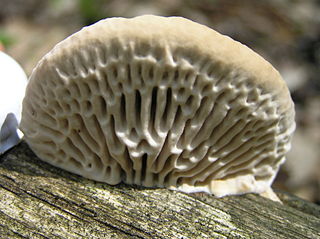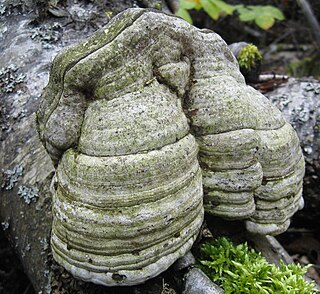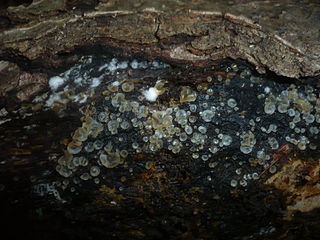
Daedalea is a genus of fungi in the family Fomitopsidaceae. The genus was circumscribed in 1801 by mycologist Christian Hendrik Persoon, based on the type D. quercina and four other species. The generic name is derived from the Ancient Greek δαιδαλεος.

Fomes is a genus of perennial woody fungi in the family Polyporaceae. Species are typically hoof-shaped (ungulate). New growth each season is added to the margin, resulting in a downward extension of the hymenium. This often results in a zonate appearance of the upper surface, that is, marked by concentric bands of color.

Lentinus is a genus of fungi in the family Polyporaceae. The genus is widely distributed, with many species found in subtropical regions.

Urnula is a genus of cup fungi in the family Sarcosomataceae, circumscribed by Elias Magnus Fries in 1849. The genus contains several species found in Asia, Europe, Greenland, and North America. Sarcosomataceae fungi produce dark-colored, shallow to deep funnel-shaped fruitbodies with or without a stipe, growing in spring. The type species of the genus is Urnula craterium, commonly known as the devil's urn or the gray urn. Urnula species can grow as saprobes or parasites having an anamorphic state. The anamorphic form of U. craterium causes Strumella canker, on oak trees.

Phlebia is a genus of mostly crust fungi in the family Meruliaceae. The genus has a widespread distribution. Phlebia species cause white rot.
Karstenia is a genus of fungi in the order Rhytismatales. The relationship of this taxon to other taxa within the order is unknown, and it has not yet been placed with certainty into any family.

Otidea is a genus of fungi in the family Pyronemataceae. The genus is widely distributed in northern temperate regions.

Job Bicknell Ellis was a pioneering North American mycologist known for his study of the Ascomycetes, especially the grouping of fungi called the Pyrenomycetes. Born and raised in New York, he worked as a teacher and farmer before developing an interest in mycology. He collected specimens extensively, and together with his wife, prepared 200,000 sets of dried fungal samples that were sent out to subscribers in series between 1878 and 1894. Together with colleagues William A. Kellerman and Benjamin Matlack Everhart, he founded the Journal of Mycology in 1885, forerunner to the modern journal Mycologia. He described over 4000 species of fungi, and his collection of over 100,000 specimens is currently housed at the herbarium of the New York Botanical Gardens. Ellis had over 100 taxa of fungi named in his honor.

Hyalorbilia is a genus comprising 10 species of fungi in the family Orbiliaceae. The genus was circumscribed in 2000.

Trichoglossum is a genus of fungi in the family Geoglossaceae. They are commonly called hairy earth tongues. The type species is Trichoglossum hirsutum.

Elias Judah Durand was an American mycologist, and botanist. He was one of the foremost American experts on the discomycetes.
Vizella is a genus of leaf-inhabiting fungi in the class Dothideomycetes, and the type genus of the family Vizellaceae. The genus was circumscribed by Pier Andrea Saccardo in 1883.
Richard Paul "Dick" Korf was an American mycologist and founding co-editor of the journal Mycotaxon. He was a preeminent figure in the study of discomycetes and made significant contributions to the field of fungal nomenclature and taxonomy. Korf was Professor Emeritus of Mycology at Cornell University and Director Emeritus of Cornell University's Plant Pathology Herbarium.

Isaria is a genus of fungi mostly in the order Hypocreales and family Clavicipitaceae, or by some authorities the Cordycipitaceae. It includes a large number of entomopathogenic species, some of them exploited as biopesticides : often previously assigned to the genus Paecilomyces.











